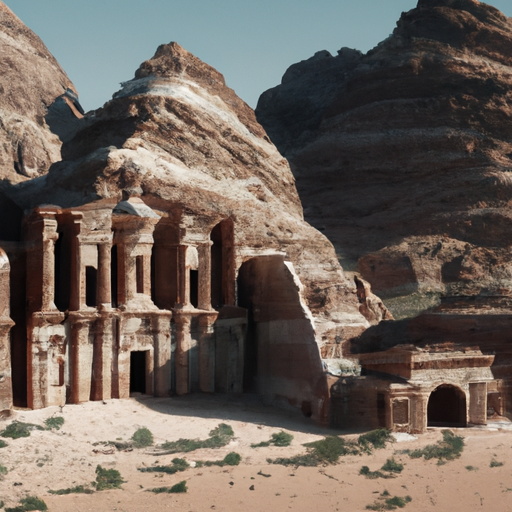Petra, a historical and archaeological city in southern Jordan, is often referred to as 'a rose-red city half as old as time'. This UNESCO World Heritage site, famous for its rock-cut architecture and water conduit system, has much to offer. This blog post delves into the rich past and captivating structures of Petra, providing a detailed look at its history, significance, architectural marvels, and current conservation efforts.
1. 'Petra: An Introduction – Who Built This City of Stone?'
Nestled amidst the rugged mountains and vast desert landscapes of Jordan, the ancient city of Petra stands as a testament to the ingenuity and craftsmanship of its creators. Carved into the rose-colored sandstone cliffs, this UNESCO World Heritage Site is an architectural marvel that has captivated travelers and historians alike for centuries. But who were the masterminds behind the creation of this awe-inspiring city?
Dating back to the 6th century BCE, Petra was originally settled by the Nabataeans, an Arab civilization renowned for their trade and caravan routes. This industrious and resourceful civilization utilized their strategic location along the ancient spice and incense trade routes to establish a bustling hub of commerce and cultural exchange. Through their ingenuity and engineering skills, the Nabataeans transformed the rocky landscape into a thriving city, complete with temples, tombs, and elaborate facades.
The Nabataeans' ability to carve intricate structures directly into the cliffs is particularly remarkable. Their mastery of rock-cut architecture is evident in iconic structures like the Treasury (Al-Khazneh), which served as a mausoleum for Nabataean kings. The delicate details and precision in the carvings showcase the advanced skills of the craftsmen who worked on these monumental structures. Additionally, the city's water management system, with its intricate channels and cisterns, reveals the engineering prowess of the Nabataeans, who ingeniously harnessed the scarce water resources of the region.
Despite the mystery that surrounds the Nabataeans' eventual decline, their legacy lives on through the stunning ruins of Petra. Today, visitors can wander through the narrow Siq, a winding gorge that leads to the heart of the city, where they can marvel at the grandeur of the Royal Tombs, the intricacy of the Monastery, and the remnants of a once-vibrant trading center . Each step through the ancient city's stone pathways is a step back in time, offering a glimpse into the rich history and cultural heritage of this remarkable civilization.

An aerial view of Petra, showcasing the vast expanse of this ancient city.
2. 'Unraveling the Architectural Marvels: What Makes Petra Unique?'
Petra's uniqueness lies not only in its grandeur but also in the remarkable fusion of various architectural styles and influences. The Nabataeans, who were highly skilled in adapting and incorporating different cultural elements, blended Hellenistic, Egyptian, and indigenous Nabataean architectural styles to create a truly distinctive city. The result is a breathtaking amalgamation of classical, Eastern, and local aesthetics.
One of the defining features of Petra is its intricate rock-cut facades. The skilled craftsmanship and attention to detail are evident in the ornate carvings and elaborate motifs that adorn the tombs and temples. The façade of the Treasury, with its impressive Corinthian columns and intricate friezes, exemplifies the grandeur and beauty of Nabataean architecture. The blend of Greek and Eastern elements in this structure showcases the cultural exchange and cross-pollination that took place in ancient Petra.
Another architectural marvel in Petra is the Monastery, located high up in the mountains. This massive structure, also known as Ad-Deir, stands as one of the largest rock-cut facades in the city. Its sheer size and the intricate details carved into the stone walls leave visitors in awe. The Monastery is a testament to the innovative engineering techniques employed by the Nabataeans to create such monumental structures in challenging terrain.
Aside from the rock-cut architecture, Petra is also known for its impressive water management system. Despite the arid desert environment, the Nabataeans developed an elaborate network of channels and cisterns to collect and distribute water throughout the city. The ingenious engineering techniques used to capture and store water highlight the advanced knowledge and expertise of the Nabataeans in managing precious resources.
The overall layout and planning of Petra are also noteworthy. The city was designed with precision, taking advantage of the natural landscape and incorporating it into the architectural composition. The strategic placement of buildings, the winding pathways, and the hidden niches all contribute to the unique character of Petra, making it a true marvel of ancient urban planning.
One option to see all it's wonders is to go on eilat petra tour and so enjoy all it has to offer.
3. 'Why did Petra Fall into Oblivion? The Rise and Fall of a City'
Over time, Petra's prominence waned, and the city fell into oblivion. Several factors contributed to its decline and eventual abandonment. Firstly, the decline of the Nabataean civilization itself played a significant role. With the Roman Empire expanding its reach, the Nabataeans gradually lost their independence and influence in the region. This shift in power meant a decline in trade routes and economic activity, negatively impacting Petra's prosperity.
Additionally, the rise of new trade routes and the changing political landscape diverted attention away from Petra. The emergence of maritime trade routes in the Red Sea and the decline of the overland caravan routes that once passed through Petra contributed to its isolation. This isolation further accelerated the city's decline as it lost its strategic position as a major trade hub.
Furthermore, natural disasters, such as earthquakes, also took their toll on Petra. The city's stone structures, while impressive, were susceptible to the destructive forces of seismic activity. The repeated earthquakes weakened the structures and made the city less habitable.
Finally, the invasion of the Roman Empire marked the final blow for Petra. The Romans, with their own architectural and cultural preferences, did not invest in the maintenance and preservation of Petra's unique buildings and infrastructure. As a result, the city gradually faded from memory, its grandeur hidden beneath layers of sand and time.
It wasn't until the early 19th century that Petra was rediscovered by Swiss explorer Johann Ludwig Burckhardt, bringing it back into the limelight and sparking renewed interest in its preservation and study. Today, efforts are being made to conserve and protect Petra's historical significance, ensuring that the legacy of this once-great city remains accessible to future generations.

A panoramic image of the Royal Tombs, displaying intricate carvings.
4. 'Conservation Efforts: How Are We Preserving History?'
Preserving the historical site of Petra is a collective effort involving local authorities, international organizations, and passionate individuals. Recognizing its significance as a UNESCO World Heritage site, conservation efforts have been put in place to protect and restore the architectural wonders of this ancient city.
One of the key conservation initiatives is focused on stabilizing and preserving the fragile rock-cut structures that define Petra. This involves employing experts in architectural conservation and geology to assess the stability of the structures, identify areas of risk, and implement necessary interventions. Techniques such as structural reinforcement, consolidation of weakened areas, and protection against weathering and erosion are employed to ensure the long-term preservation of the site.
In addition to structural conservation, efforts are being made to safeguard Petra's unique cultural heritage. This includes documenting and cataloging the numerous archaeological finds discovered within the site. Archaeologists meticulously excavate and study these artifacts, shedding light on the daily lives, customs, and beliefs of the Nabataean civilization. Digital technologies, such as 3D scanning and virtual reconstructions, are also utilized to preserve and present these findings to a wider audience.
Furthermore, sustainable tourism practices are being implemented to balance the need for access to the site while minimizing its impact on the fragile environment. The number of visitors is carefully regulated, and measures are in place to ensure responsible tourism, including waste management, preservation of natural resources, and education programs for visitors.
Exploring Petra is akin to turning the pages of a living history book. Each monument, from the imposing Al-Khazneh to the intricate Royal Tombs, tells a tale of ancient cultures, architectural genius, and human resilience. As we stride towards the future, it becomes crucial to preserve these historical footprints that contribute to our understanding of human civilization. Petra is not just a historical site; it is a testament to the enduring spirit of mankind.





